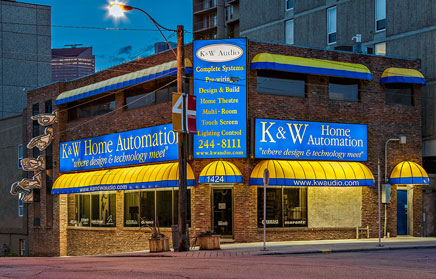TIP# 35:
So, we’ve decided to take the plunge and create our very own dedicated Home Theatre. We know what we want, but we may not be absolutely sure of the best way to get there. What should be done as far as wiring goes, how should the room be set up, and what considerations should be taken into account for future modifications?
Running cables for home theatre is similar to pre-wiring for multiroom audio (see tip #33) in that you will probably end up with a bunch of drywall dust in your hair. However, we should think more carefully about the way the system is going to be used, since with home theatre the speaker positions are a little more constrained than for ambient room fill, and all must relate to the position of the TV and the viewers.
First off, let’s decide where the TV should be. Ideally we would like it to be situated in the middle of a wall with adequate space on either side of it to accommodate the main channel loudspeakers you have in mind. A fireplace in the room almost always requires placing the TV set in the corner, and this starts the compromises rolling. Don’t despair though if this is your situation, as we have resolved this placement problem many times. In our example we are trying to end up with an ideal, dedicated Home Theatre room. So for now, lets forget about the Family Room with a fireplace, and go on to another less utilized room that offers no such restrictions.
In our design, we have established a place for the screen, and adequate space for the main channel loudspeakers. The viewers’ listening position is our next step. Ideally we would like to position our chair, or couch, so that there is a minimum two feet of space between it and the back wall. Seating should be arranged to form the third point of an equilateral triangle with the two main speakers – life is good. If this positioning is not possible, the listening position may be increased by as much as half the distance from the screen, the result will still be outstanding. It is important to keep at least two feet from the back of the couch to the rear wall.
Having established our main speaker, screen, and listening position, rear channel speaker placement is easy. They should be positioned opposite the main speakers, on the rear wall. If it was not possible to get the couch off the back wall, the rears should now be installed on, or in the walls to either side of the couch.
Next we must decide where to put a sub-woofer. Sub-woofers are an absolute must in a quality Home Theatre System. Even though you may only have one, or maybe none right now, dual sub-woofers do the best job, and some remarkable musical things as well. By working in stereo, rather than each receiving the same monaural output, and placed to the right and left of the room, the enhanced sense of depth and space can elevate your Movie enjoyment well beyond the mere cineplex experience. If design or other constraints allow for one only in the room, don’t fret, a quality single sub will still shake the walls when T-Rex arrives.
As for placement, putting the sub close to the listening position allows the sub to work the least in order to reach the listener. Putting it in a coffee table, or rear of couch position works very well. A word of caution, if you want to place it up front with the main loudspeakers, don’t place it in the center of the wall between the loudspeakers, the subwoofer can cancel itself, or the bass produced by the main speakers. Placed off a little to one side works best in this situation.
Now to locate the Audio/Video equipment. After careful consideration as to the location of the equipment, and the needs of the listener, the wonderful task of wiring can begin in earnest. If the room can be wired before drywalling, great. However, if you are doing a retro install keep in mind that the philosophy remains the same.
Here are some general rules. Always use high quality speaker and sub-woofer cable to all loudspeaker locations, even if you have a Pro-logic system now. Chances are you will want to upgrade to AC-3 some time in the future, and we may as well make sure that we are ready to go when that time comes. Locate power plugs near the sub-woofer locations, or vise versa. Almost all subwoofers have amplifiers built into them these days, and a long extension cord is an eyesore. When running speaker, and pre-out cables, keep away from power lines. Resist the temptation to use the holes made by the electrician. We do not want to hear power line hum! If a power line must be crossed, do it at a 90 degree angle. This will minimize the potential for noise and hum later on. Make a diagram of where all the wires have been run. This can be invaluable two or more years down the road, when a new application comes to light and you really need to know where to drill ONE hole.
OK, down to the nitty gritty. From the equipment location, run your main speaker cables to the wall area behind the main speaker positions. If you are unsure as to whether you will be using in-wall or freestanding speakers, run the cable to that location and then up the wall (as we do in multiroom wiring). This allows us the flexibility to change, or delay our decision. Run a third speaker cable to tile TV location, leaving enough slack to be able to move the set, or the speaker. Many people run to wall plates, especially for the mains if they are freestanding. The TV usually hides the center channel cables egress from the wall.
For the rear speakers, run the cables from the main system area, up the wall, then to a position directly above the main speaker locations. (Right rear over the right main speaker location and left rear over the left main speaker location). Now run the wire directly to the rear wall and down to the door. Even if you know you are going to be running in-ceiling, in-wall or oil-wall loudspeakers, this gives us the flexibility to change the rear speaker setup by referring to our wiring diagram (we did make one didn’t we?) The ability to access a wire in the new location is a real joy. Most sub-woofers require a pre-amp output cable, while some need a speaker cable input. If you are unsure as to what will be needed, be safe, run a coaxial pre-amp cable along with a four conductor speaker cable to your subwoofer location. Wall plates are frequency used here. They allow us to move the sub location and still have a finished wall after the sub box has been moved.
Planning the Audio/Video cables that run between the TV and the stereo should be considered as part of the pre-wire, along with remote triggers (for motorized screens) and IR sensors. These are best left to a professional to spec out, since there are usually several different ways to hook up a Home Theatre, depending on the sophistication of system’s remote capability, no single rule can apply here. We offer free cable routing consultation, so if you would like our input just give us the specs for your existing and upcoming equipment and a sketch or room plan. We can then draw up a plan for you that will have your Home Theatre sounding its best, with the least amount of hassle. Or…we can have our installers do it all for you!


